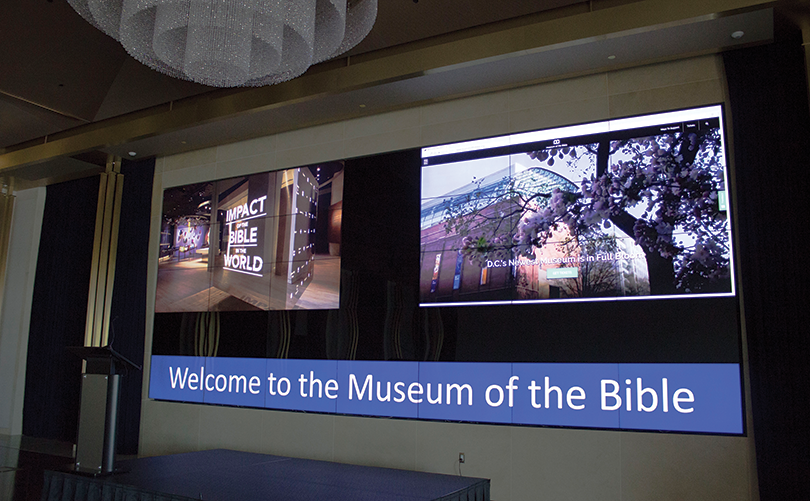The rapid convergence of our digital worlds is increasing the demand for multi-use displays. At many institutions, LCD panels and videowalls are used to display a variety of content, including digital signage, streaming media and presentations. Although most signage systems permit the display of different kinds of content, they often fall short of the kind of flexibility that users require. The best way to ensure that the display system satisfies current and future client needs is to conduct a comprehensive needs analysis—not just the needs of your primary contact or the purchasing executive, but, rather, the needs of all the stakeholders, including the typical user and the staff responsible for managing the system.
Digital signage content creators are usually familiar with the options available to them to add a variety of content—free time and weather widgets available with the Content Management Software (CMS), and news and other broadcast content available through subscriptions. However, when clients are requested to add another content source—for example, a speaker’s slides—to the same digital signage matrix, they are usually stumped. That’s why it’s important to identify all the types of content the client might have to display now, or might wish to display in the future.
Another important consideration is whether the users will have tech support available when they have to display new content. Several situations, such as streaming video of a live event on a signage screen, might necessitate real-time tech support. It is a good idea to train the client’s AV/IT staff on how to configure the system for various uses, such as emergency messaging, streaming video or speakers’ presentations.
Hardware and software selections heavily affect the ability to display a wide range of content. Although cost is always a key factor in configuring a system, a solution that does not properly fulfill key content requirements is, ultimately, of little value. For example, if you are using a videowall to display content, you will need the appropriate hardware and/or software to ensure that still images and videos scale properly. Another key consideration is the maximum number of displays supported. Some platforms also feature low-latency native playback of IPTV streams up to 4K, or support for interactive content. For signage networks that display IPTV content, it will also be necessary to select a platform with Digital Rights Management (DRM) integration. To find the best fit for your requirements and your budget, you might have to check out solutions based on both proprietary and open platforms.
If the digital signage network is advertiser supported, it would be necessary to select software that shows scheduling of the advertisement or “proof of play”—and, in some cases, monitoring cameras might be installed for “proof of display.”
Let’s take a look at a recent deployment of a multi-purpose videowall and learn from the insights the project offers.
At the Museum of the Bible, which opened in Washington DC last fall, there are nine videowalls, but only two of them are capable of displaying multi-source content simultaneously. Those two videowalls are in the Gathering Room, a divisible ballroom in which a variety of events is held. Each of the massive videowalls consists of 35 LG 55-inch LCD panels with external receivers (zero client devices), and one PC/server. The content typically displayed consists of still images and videos from the networked servers, and, during events, the speaker’s presentation is served up from a laptop PC or other external player device connected to the HDMI input on the display.
When researching the project, I spoke with the museum’s Manager of IS Infrastructure, Jeremiah Tribble, who was also responsible for overseeing the AV systems design and implementation throughout the facility. Discussing the Gathering Room, Tribble said, “We needed the ability both to display digital signage content in a schedule-driven format and to display content from in-room HDMI feeds from laptops for presentations.” Tribble said the primary criteria in system design and component selection were ease of use, flexibility to accommodate future requirements and requests, and remote manageability over the network.
According to Tribble, a key component of the system is the Userful videowall software. “We did not have to add separate in-line hardware to scale content for the displays,” he said. “With Userful software, a standard PC/server connects to displays via a webpage hosted on the Userful server over the network and the videowall can be controlled locally, or you can centrally manage multiple videowalls across multiple sites through the network,” he explained.
Tribble was enthusiastic about Userful’s ability to handle very large content files for display across very large videowalls. He said, “In addition to handling multisource situations with a mix of different inputs from different sources, it can also handle odd aspect ratios. It offers advanced interactivity features, API and remote manageability….”
Tribble also offered the following three suggestions regarding the selection of hardware: (a) Will you be showing dark/high-contrast content frequently? If so, seriously consider selecting a panel with multi-zone local dimming for its backlighting, rather than the cheaper edge-backlit panels. (b) Consider your panel connections and their standards carefully. If you have a 2×2 matrix of panels that are daisy-chained together for video signal and you want to feed them a 4K signal, the HDMI/DisplayPort connections must support the throughput needed (DP 1.2 or greater, HDMI 1.4 or, preferably, 2.0 or greater). (c) Does the input port/panel support HDCP 2.2? If your goal is to show copyright-protected 4K content, your panels must be able to support HDCP 2.2.
Not all clients can easily grasp the complex possibilities involved in providing an easy-to-manage solution that meets all their content-source needs and various user situations. For that reason, you might have to provide a matrix that shows the choices in terms of both cost and operational complexity. It seems clear that helping clients to make intelligent, scalable choices could be one of the greatest value-adds you could offer in an increasingly complex world.
